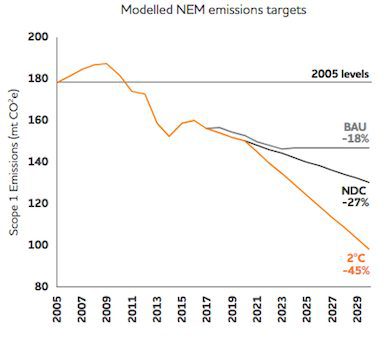Origin Energy has revealed plans to set its own company-wide, “science based” carbon reduction target by the end of this year, and increase its renewable energy capacity to 25 per cent of its generation portfolio in 2020, in a report outlining its position on climate change and the decarbonisation of Australia’s electricity market.
Origin released the report – The Resilience of Origin’s Energy Generation Portfolio to a Low-Carbon Economy – on Wednesday, to coincide with its annual general meeting, and alongside a notably short statement of broad, but cautious, support for the federal government’s newly proposed National Energy Guarantee.
After noting that the gen-tailer had supported all 50 of the Finkel Review recommendations, including that for a Clean Energy Target, Origin chairman Gordon Cairns said the company supported the federal government’s proposed National Energy Guarantee.
In a statement in Origin’s annual general meeting report, Cairns said the NEG “had the potential address the objectives of ensuring security, affordability and facilitating the transition to a modern, cleaner energy future by unlocking investment in more supply.”
But a closer look at the gen-tailer’s decarbonisation plan, and the comments made in both the AGM report and the company’s Scenario Analysis, suggest Australia’s electricity sector is taking its carbon reduction task rather more seriously than the Coalition.
For starters, Origin has restated its commitment to exit all coal-fired power generation by the early 2030s.
For Origin this is not such a major deal. It means closing the company’s only remaining coal plant, the 2,880MW Eraring Power Station in New South Wales.
But it does make an interesting contrast with comments made by federal energy minister Josh Frydenberg in Parliament on Tuesday, who said that 64-72 per cent of the generation mix in the NEM would coming from coal and gas in 2030, under the NEG.
Frydenberg pointedly refused to state what percentage of that number would be from coal-fired power alone, but it is quite possible Origin’s Eraring won’t be in the mix, and AGL’s Liddell almost certainly won’t.
It is less clear what EnergyAustralia will be doing by that time, but it’s safe to say it won’t be building new coal plant, considering recent comments from chief Catherine Tanna that new coal power was “a solution that my grandfather would have built. I think it is very, very unlikely to find a market participant that will fund such a new investment.”
In further contrast with the government’s new energy plan, Origin has also stated in both its AGM report and its carbon analysis report, that it believes a zero emissions electricity sector is achievable for Australia by 2050, “or earlier”.
Origin also differs with the federal government on how much of Australia’s abatement task should fall to electricity generators, stating clearly in its Scenario Analysis that the sector should be responsible for cutting more greenhouse gas than it emits.
“With its ready access to a range of low-carbon solutions which can be rolled out at scale, we believe the electricity sector should be responsible for more than one-third of any national emissions reduction target,” it says in the report.
Of course, this is in line with a range of climate policy modelling – including from Finkel – that shows cutting emissions from the electricity sector as the cheapest and easiest way for Australia to meet its international climate commitments.
The NEG, however, would direct the electricity sector to account only for the emissions it produces, and only in line with the federal government’s low-ball 2030 target of 26-28 per cent reduction on 2005 levels.
 Origin’s renewable energy target also aims significantly higher than the Coalition’s goal of 23 per cent renewables by 2030, as well as its NEG-based projections of 28-36 per cent renewables by that date, of which wind and solar would be around 18-24 per cent.
Origin’s renewable energy target also aims significantly higher than the Coalition’s goal of 23 per cent renewables by 2030, as well as its NEG-based projections of 28-36 per cent renewables by that date, of which wind and solar would be around 18-24 per cent.
“We are rapidly growing the share of renewables in our portfolio with a target of renewables comprising more than 25 per cent of our generation mix by 2020 – up from around 10 per cent today,” Origin said in its report.
“Since March 2016, we have committed to approximately 1,200 MW of new renewable energy supply which will come on line progressively over the coming years and support a competitive cost of energy.
“Beyond 2020, we expect renewables will continue to play a key role in maintaining a competitive cost of energy and achieving our emission reduction targets.”
On climate, Origin also appears to be talking the talk – a strategy it clearly understands is expected of it by shareholders.
“This is the first time we have produced a standalone document to convey our position and outline the preparedness of our business to prosper in a lower carbon world,” the report says.
“We have consistently stated our unequivocal support for measures to reduce carbon emissions, including the Paris Agreement, in order to hold global average temperature rises to well below 2°C.
“We support Australia’s 2030 emissions reduction target and have advocated for the implementation of government policies to ensure this can be achieved. We also believe a goal of net zero emissions in the electricity sector by 2050 or earlier is possible.”
Origin outlines a “five pillar approach” to progressively decarbonise its business, including: the exit coal-fired power generation by early 2030s; to significantly grow renewables; to leverage its strong gas position; to empower customers with cleaner, smarter energy solutions; and to demonstrate leadership in climate change advocacy.












